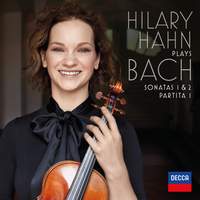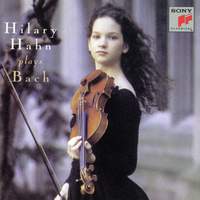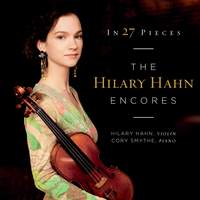Interview,
Hilary Hahn on Bach
 American violinist Hilary Hahn launched her recording career in 1997 with astonishingly assured accounts of three of JS Bach’s sonatas and partitas for solo violin, set down when she was still in her teens; two decades on, she completed the set with a second instalment which my colleague Graham described as ‘75 minutes of authentic and profound Bach playing of the highest standard’. I spoke to her recently about how far her perspective on this music has shifted over the course of the intervening two decades, how she approaches Bach in front of a microphone, and the impact of collaborating with living composers upon her interpretations of these works.
American violinist Hilary Hahn launched her recording career in 1997 with astonishingly assured accounts of three of JS Bach’s sonatas and partitas for solo violin, set down when she was still in her teens; two decades on, she completed the set with a second instalment which my colleague Graham described as ‘75 minutes of authentic and profound Bach playing of the highest standard’. I spoke to her recently about how far her perspective on this music has shifted over the course of the intervening two decades, how she approaches Bach in front of a microphone, and the impact of collaborating with living composers upon her interpretations of these works.
It's twenty years since you recorded the other three sonatas and partitas: was it always the plan to leave such a long interval?
No, actually there was no plan to do the other part at all! It was my very first recording, so I simply did the three pieces that I was most familiar with at the time. It turned out to be pretty popular and almost immediately people started asking me when I would record the rest, which was a bit of a surprise because it hadn't even occurred to me to do the whole lot. Then I started exploring other things, and I figured that because these are solo works I could probably go back to them in the studio pretty easily – there are no other people to factor in except for the crew, so I just let time pass. I played the pieces a lot, and I liked having it in front of me as something I could do in the future. Then the future arrived, and I felt it was time to finish the set.
Yo-Yo Ma recently revisited the Cello Suites on disc for the third time in his career - were you tempted to record the entire set this time around?
I was 16 or 17 when I did those first sessions, and when I go back and I listen of course there are things that I would do differently now, but I feel like that the morning after pretty much every concert that I do. It’s not that I dislike it, but just that I am constantly getting new ideas: every day is different, and the way I look at a recording is as a representation of that day. My philosophy is that you can’t make a piece of music be a way it doesn’t want to be on a particular day. I don’t presume to speak for everyone, but for me that is definitely the case. There are a few stylistic differences between the two recordings, but I think I still felt like the same person, and I don’t disagree with what I did the first time round. I see it as one step along the way, and the current recording as another, and the only time you really arrive is the last time you ever play the instrument: that’s as evolved as you are going to get!
Did you use the same violin for both recordings?
No, and in fact the new recording was made on two different violins: I wasn’t even intending a sequel recording, but I wanted to see what was there in this repertoire now in front of the microphone. I did two separate sessions [in 2011 and 2017], and some of the pieces overlapped, though the majority of the recording comes from the later one. In the intervening years I switched violins, but not by very much: the second one is also a Vuillaume and it’s just one year younger than the previous one, which I had been playing for most of my career. The feel of the instruments and the tone production are very similar, so it was a very smooth transition for me; even playing the two side-by-side on the recording, it just took a few tiny adjustments with audio technology to make them sound exactly the same.
How do you break these works down in the studio: do you aim to record entire movements or works, or go for a more piecemeal approach?
I generally do full takes, but it’s not always seamless. Sometimes it doesn’t always work the way you want it to work, so for the most part I try to record as big a chunk as possible and maybe dovetail with whatever is there from the previous day. And sometimes I just get tired in the sessions (especially with Bach and all those repeats) so we will do a half-movement. But any time you isolate any part of the movement you run the risk of losing flow, and because I tend to go with what the music wants to do on the day rather than what I have practised, it’s acutely important for me to go with that flow rather than getting hung up on details. An orchestral recording is so different, because there are so many variables - perhaps some note was off, or the recording-levels need adjusting - and with so many people involved you are often on a very tight schedule, so it’s a case of making sure that you have as much covered as possible. But in solo sessions there is more breathing-space, and if something's not working one day, I can do it the next.
Part of the challenge for me is also that I know how to project in a concert hall, but being in front of a microphone requires a different kind of playing: things that I think are going to work sometimes just don’t translate, so I have to approach them a different way to get the same result. It can take a while for the body to settle and become comfortable with that: it’s a very strange disconnect, but you cannot be disconnected when you are playing this music.
Over the past twenty years, have you had any experiences or encounters with other musicians and composers that have particularly informed your perspective on Bach?
This is a very general point, but whenever I have a good musical connection with my colleagues, I can try things that I haven’t tried before. Working with an orchestra often gives me a chance to explore different ways to layer and draw attention to multiple voices, and I can bring that into my solo work, particularly Bach. The commissioned pieces that I have done have taught me a lot about working on different kinds of music without any guidelines besides the score and the composer’s influence: developing an interpretation from scratch is very different from having a recording to play and an interpretation to copy. I gained so much from working with so many composers on the Encores project - not least, realising that different composers can mean entirely different things by the same word. For instance, by ‘rubato’, Composer 1 might mean 'start slow and catch up', whereas Composer 2 might mean ‘Start with a flurry and expand. And someone else might write instructions in the music but not really be attached to any of that, whereas another person might want you to try to do everything.
I recently commissioned [Spanish composer] Antón García Abril to write a set of six solo polyphonic works, which I think is a very particular sub-genre within the repertoire; I got my first experience of working on a set of works by a single composer written for me, and Antón had a really great way of writing for solo violin with multiple voices that I hadn’t seen before. It was extremely different from Bach’s style of writing, but he writes a lot of freedom into his music which ultimately helped me in my performances of Bach, and I think you can hear a little bit of that in the new recording.
'This is quite simply magnificent violin-playing, the sort that while you’re listening to it convinces you that the music couldn’t possibly be played any other way…you soon realise just how far she’s come since her teenage years, the tempo marginally more mobile and the variety of nuance and tone on offer so much wider than it had been...I adored it.' (Gramophone)
Available Formats: CD, MP3, FLAC, Hi-Res FLAC
'This is simply a magnificent performance, completely true in all its parts and possessed of a depth and wisdom that belie the performer's age. Unlike most of the violinists who play this music, she is truly its master, and that frees her to play it with soul.' (Stereo Review)
Available Formats: CD, MP3, FLAC
'Hahn burnishes whatever she plays with her heart, her soul and her supreme technique and Smythe is an ideal comrade, with notes and modes of attack shifting in rainbow colours.' (The Times)
Available Formats: MP3, FLAC





